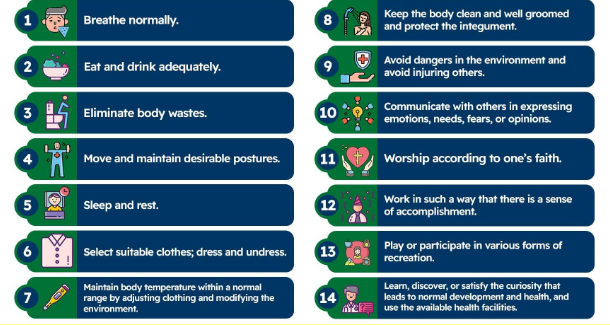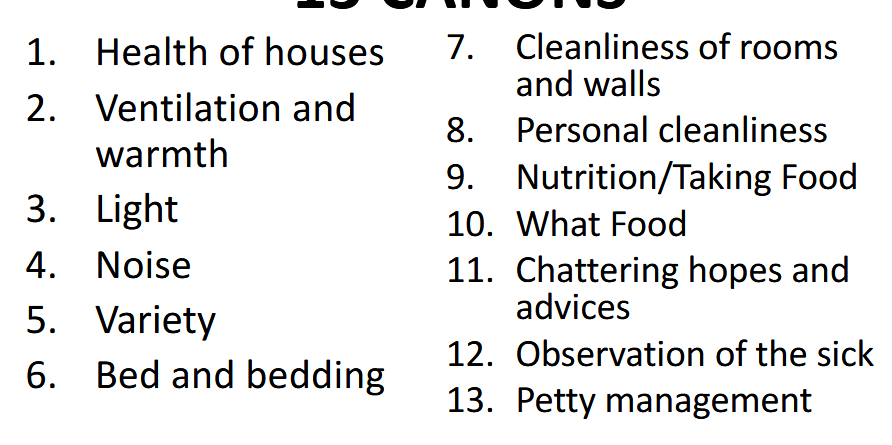Theoretical Foundation of Nursing
1/102
Earn XP
Description and Tags
Theories and Founders
Name | Mastery | Learn | Test | Matching | Spaced |
|---|
No study sessions yet.
103 Terms
Florence Nightingale
Founder of modern nursing, author of “Notes in Nursing” nursing from vocation to profession
Curriculum Era (1900s-1940s)
Emphasizes courses included in nursing
Research Era (1950s - 1970s)
Emphasizes role of nursing and what to research
Graduation Education Era (1950s - 1970s)
Emphasizes caving out advanced roles and basis for nursing practice
Theory Era (1980s - 1990s)
Emphasizes on the many concepts about nursing
Theory Utilization Era (21st Century)
Emphasizes on using the theories into practice
Sigmund Freud’s Psychosexual model
Associated with different pleasurable zones for gratification
Erik Erikson’s Psychosocial model
Individuals need to accomplish a particular task before completing the stage
Oral, 2. Anal, 3. Phallic, 3. Phallic, 4. Latent, 5. Genital
Psychosexual Theory
Oral (Psychosexual model)
18 months, thumb sucking
Anal (Psychosexual model)
12-18 months, bladder control
Phallic (Psychosexual model)
3-6 yrs old, fantasized about parent of the opposite sex
Latent (Psychosexual model)
6-12 yrs old, sexual urges repressed, socially acceptable
Genital (Psychosexual model)
Puberty to Adulthood. sexual urges awaken
Trust vs Mistrust
Stage 1, 1 years old, infant
Autonomy vs Shame and Doubt
1-3 yrs, Toddler,
Initiative vs Guilt
Stage 3, 3-6yrs old, Pre-School
Industry vs Inferiority
Stage 4, 6-11yrs old, School age
Identity vs Role Confusion
5th stage, 12-18 years old, puberty
Generativity vs Self Absoption and Stagnation
Stage 7, 40-65 yrs old, Middle age,
Integrity vs Despair
Stage 8, 65+ yrs old, old age
Sensorimotor stage
1st stage, 2 years, senses and actions, Object permanence
Preoperational Stage
Stage 2, 2-7 years, Symbolic thinking, imagination, lacks logic
Concrete operational stage
Stage 3, 7-11 yrs, logical thinking, conservation, reversibility
Formal Operational Stage
Stage 4, 12 years and up, hypothetical reasoning, deductive logic
Self-Actualization, Esteem, Love and Belonging, Safety needs, Physiological needs
Maslow’s Hierarchy of Needs
Internal esteem needs
self respect
external esteem needs
social status, reputation
Florence Nightingale
May 12, 1820 - August 13, 1910, Florence Italy in a Wealthy British Family during Crimean war (1854), 1st founder of modern nursing and theories,
Nightingale Theory
First nursing theory, focused on changing and manipulating environment, nursing environment can help body repair itself, with their 13 CANONS
Health of Houses
overall health of environment
Venilation and Warming
Fresh air: essential, well ventilated comfortable temperatures (36.5-37.5)
Light
likely to face window, lack = ICU “intensive care psychosis”
Noise
a patient should never be waked intentionally, whispering = unnecessary noise
Variety
stimulating environment can improve patient well being
Bed & Bedding
patient comfort, remove soiled diapers, keep bed dry
Cleanliness of rooms and walls
to prevent infection, ex. damp cloth, keep free from dust dirt and mildew
Personal cleanliness
Good skin integrity, nurse and patient well groomed, no injuries (turn patient every 2 hours)
Nutrition Taking Food
Food, variety, diet applicable, monitored
What Food
Quality and type of food, customizing meals,
Chattering hopes and Advices
False assurance: non-therapeutic; chismis, personal talk, disclosing patient’s diagnosis
Observation of the Sick
keen observer, cephalo-caudal (head to toe assessment), vital signs
Petty Management
Attention to detail, maintaining schedules, organization and resource management, ex. ensuring supplies
Virginia Henderson (Definition and Components of Nursing)
Creator of Need Theory and 14 Basic needs of patients | Born Nov. 30, 1897 - March 19, 1996, Kansas City Missouri USA, Army School (1921), BS Columbia Uni, and Master of Arts (1932-1934)
Virginia Henderson
First Lady of Nursing, promotes Patient independence
14 Basic Needs
Assisting individuals in performance, contributing to health, recovery or peaceful death, to achieve independence
14 Basic Needs

13 Canons

Faye Glenn Abdellah (Patient-Centered Approaches)
“21 Nursing Problems” March 13, 1919 - Feb 24, 2017, New York | BSN (1945), Master of Arts (1947), Doctor of Edu Columbia Uni (1955) | Served USPHS (1949-1989)
Faye Abdellah
First nurse and first woman to serve as Deputy Surgeon General (1972) promoted ot research-based discipline | standardized nursing language,
Patricia Benner (Novice to Expert Model)
Model widely used in nursing education, recognized for practical experience | 1942, Hampton Virginia, BSN from Psadena, Master Surgical in UCSF, PhD in Stress UCSF; pionered phenomenology, “1984 Novice to Expert Book,”
Novice to Expert Model
Develop skills and knowledge through clinical experience, based from Dreyfus Model of Skill Acquisition
Novice, Adv Beginner, Competent, Proficient, Expert
Novice to Expert Model
Benner’s Theory
experience is the prerequisite for becoming an expert nurse: Situational learning Clinical Judgment
Novice
Little to no experience whatsoever, rules and guidelines, learning basics,
Advances Beginner
Some experience, rely on rules, lack ability to prioritize
Competent
able to prioritize, considers long term goals, (2-3 years experience)
Proficient
See situations as a whole, can anticipate needs, modify plans, intuitive, less rule-based | can recognize early sign of deterioration, regardless of complex and evolving parameters
Expert
intuitive grasp, perform tasks effortlessly, highly skilled in identifying patient needs, no longer relies on guidelines | based on intuition, split second decisions, notices subtle changes
Martha Rogers (Science of Unitary Human Beings)
Remembered as pioneering nursing theorist, for nursing practice and education, Developed Introduction to the Theoretical basis of nursing (1970), May 12 1914-March 13, 1994 Dallas, Texas, USA, Public Health Nurse and Educator,
Patients are whole beings, and interact with energy fields, and must advocate for non-invasive, holistic nursing practices
Theoretical basis of nursing (1970)
Science of Unitary Human Beings
Human being, integral with universe and are one,
Energy Fields
where both humans are integral and continuously interact
Opennes
No boundaries that stop flow of energy and interaction
Pattern
distinguish characteristic of energy field as a single wave (uniqueness in daily life; to give suggestions)
Pandimensionality
human beings are beyond traditional dimensions, non-linear domain (nature therapy)
Homeodynamics
replaces homeostasis whereas change and variability are norm
Resonancy
high low freq (what to hobbies to tone down and tone higher)
Helicacy
unpredictable continuous evolution of energy fields
Integrality
inseparably of human and environmental fields (foster aid in environment like wall supports)
Betty Neuman (Neuman Health Care Systems Model)
Known for nursing practices in various settings worldwide | 1924, Lowell, Ohio, RN, UCLA, Psychology
Neuman System Model
focusing on stress; and stressors, widely used in nursing education practice and research
I. Person Variables
Physiological, Developmental, Psychological, Sociocultural, Spiritual
Physiological variables
vital signs, body structure and function physical aspects
Psychological variables
Mental Emotional, self esteem
Developmental Variables
life stage and personal growth (marriage, pregnancy)
Sociocultural variables
expectations and activities, food preferences, caring of the dying and dead
Spiritual variables
Connection to transcendent, prophibiting blood transfusion ex. Jehovah’s witness,
II. Central Core
basic structure of individual crucial for survival; genetic makeup
III. Flexible line of defense
temporary shield; stronger = healthy, weaker = sick (ex. caffeine for all-nighters)
IV. Normal Line of Defense
Persona’s everyday protection against stress (ex. eating, skin)
V. Lines of Resistance
Come in play when stressors break through normal defenses (ex. immune system)
VI. Reconstitution
Process of recovering after a stressful event; (ex. physical therapy)
VII. Stressors
Ant force that can potentially affect stability of the system (positive or negative)
Intrapersonal Stressors
Stressors within a person, emotions, feelings, hypertension, illness
Interpersonal stressors
occur between individuals (role expectations, family conflict)
Extrapersonal stressor
occur outside the individual (job, finance, pressure, job loss)
Primary Prevention
Protecting normal line of defense, taken before stressor invades system
Secondary Prevention
an intervention after stressor has penetrated normal line of defense, aims to strenghten line of resistence
Tertiary Prevention
supporting the system after treatment, regain wellness and prevent further stress
Dorothea Orem (Self-care Deficit Nursing Theory)
Construction worker (F), Home maker (M), youngest among 2 daughters, Baltimor Maryland (1914) | developed Self-care deficit nursing theory in 1950s, formalized in 1970s
Self-care
what patients do to take care of themselves
self-care deficity
what they cant do because of illness
Self-care
independent maintenance of Health
Self Care Agency
human ability of engaging self care activities - conditioned by age, developmental state, life experience, etc.,
Therapeutic Self-Care Demand
specific set of self-care actions, for a particular health situation or condition
Self-Care requisites
needs of a person through self care to stay healthy (includes; Universal “ADL”, Developmental”Adjustments in Stages of life”, Health Deviation “Adaptation in Illness”)
Imogene King (Systems Frameowrk & Goal Attainment Theory)
Developed ‘Goal Attainment Theory’ | Jan 30-Dec 24, West point, Iowa, BSN Louis Columbia 1945-1961, | assistance chief,
Goal Attainment Theory
Theory that represents interaction, in order to achieve mutual health goal decisions (Personal, Interpersonal, Social) System
Personal System
self awareness, views, perception of own body, and psychological areas that surrounds the person, and understanding of perception of time (understanding condition)